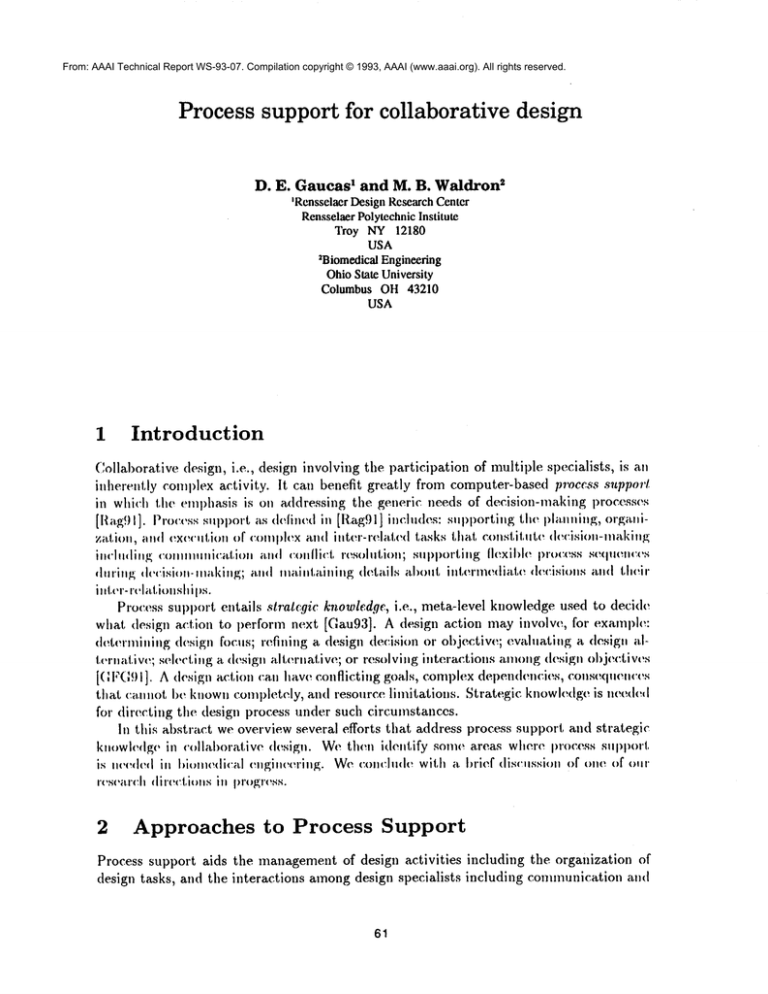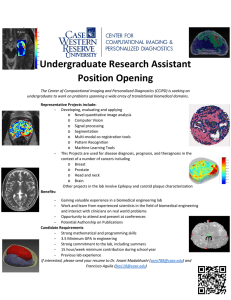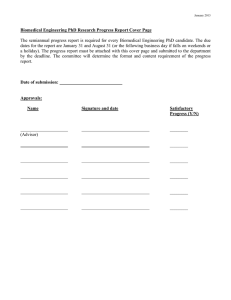From: AAAI Technical Report S-9 -0 . Compilation copyright © 199
advertisement

From: AAAI Technical Report WS-93-07. Compilation copyright © 1993, AAAI (www.aaai.org). All rights reserved. Process support for collaborative design D. E. Gaucas I ~ and M. B. Waldron ~Rensselaer DesignResearchCenter Rensselaer Polytechnic Institute 1¥oy NY 12180 USA 2Biome.xlical Engineering OhioSlate University Columbus OH43210 USA 1 Introduction Collaborative design, i.e., design involving the participation of multiple specialists, is an inherently COml)lex activity. It can benefit greatly from computer-based pTvccss support in which the emphasis is oil addressing the generic needs of decision-making processes [Raggl]. I)roccss support as (h’fim’d in [Rag91] includes: SUl)l)orting tim i)lam~ing, organization, and ext’cution of complexanti inter-r(:la.t(~d tasks that constil, ut(~ d(~cision-making inclmliwg cowmmwicatiow and conilict resohztiow; SUl)l)orting Ilexil)l(" i)v’occss s(’(lUCm:es during ~h,cisiow-ma/~iwg; and vnaild,a, ining (l(:ta.ils about int(~rmcdia,t(’ d(~cisions ~.n(I inter-r~dationshil~S. Process supl)ort entails sh’alcgic knowledge, i.e., meta-level knowledge used to decide what (lesign action to 1)erform next [Gau93]. A design action may involve,, for example: (let(~rmining design fl)cus; re, fining a design decision or ol)jectiw’; evaluating a design alt(,rnativ(’; selecting a design alt(,rnatiw:; or resolving interactions amongdesign ol)je(’tiw,s [(~ F(L91]. A design action can have conflicting goals, coml)lex del)ellden(:ies, cons(:(lUelW(’s that cannot I)e knowncompletely, and resource limitations. Strategic knowledgeis need(’~l for dir(:cting the design process under such circumstanccs. In this abstract we overview several efforts that address process support and strategic knowh,dg(, in colla.I)orative d(:sign. Weth(’n identify some areas where I)rocess SUl)l)ort in m,c&’din I~iom(~(li(:al (’ngim~ring. Wecom:lud(~ with a brief discussion of one of r(,s(’ar(:h dir(,cl, ions in progress. 2 Approaches to Process Support Process support aids the managementof design activities including the organization of design tasks, and the interactions amongdesign specialists including communication and conflict resolution. Approaches to process support include using good strategies in planning and controlling the collaborative design process, and deriving good strategies for collaboration based on past experience. Levitt et al. [L.IDgl] identify the meta-knowledge used by expert designers and design managers in managing concurrent, multidisciplinary design including knowledge to: "partition the design task for efficient execution by specialists; set appropriate levels of design conservatism for key subsystem specifications; evaluate, limit and selectively communicate design changes across discipline boundaries; and control tim sequence and timing of the key (highly constrained and constraining) design decisi,ons for a given type of artifact." Such recta-knowledge forms the basis of process support. R,<’scarchers at the Massachusetts Institute of Techm)logydetent ¢~oopt’.ralivr’-dc.~iqn process planning [KEW91]as a method of developing a stra, tegy for carrying out a design process by analyzing the structure of the design problem, i.e., the dcpendencies between its tasks and the nature of those dependencies. The goal is to "better organize the design tasks and improve coordination among designers" [Epp90]. Tasks can range from the parameter level, e.g. rotor width, to the procedure level, e.g. distribute, drawings. A strategy is modeled in terms of design tasks with information connections that allow them to be executed sequentially, iteratively, or in parallel. Numerical mea.sttres of task int<~,r<lel)<:ndence hel l) determine the effectiveness of a particular stratt:gy. The us<~ of precedence matrices for analysis aids in: sequencing tasks, initializing iterative tasks, decoupling tasks for performance, and coupling tasks for feedback. Agent interactions during the collaborative design process include the communication of goals and plans, and the resolution of competing objectives. Local strategies can be planned for supporting such interactions. For example, Lander et al. [LLC89] have identiffed sources of conflict in cooperative problem solving including resource competitio~h incomplete knowledge, incompatible goals, and different perspectives. They suggest the use of protocols for the resolution process and heuristics for strategy selection. Local strategies can be acquired for agent interactions. For example, based on a case study of the cooperative design process, Klein and Lu [KL89] have formulated a computational model of conflict resolution suitable for use in a cooperative humanand machine-based system. In such a system, a conflict occurs when two incompatible design commitments have been made or when a design agent has a ncgat, ive evaluation of another agent’s actions. Their model consists of a hierarchy of conllicts and corresponding domain-dependent and domain-independent strategies which prescribe design actions to be taken to resolve a conflict or anticipated conflict. The strategies encode conflict resolution expertise and use techniques involving, for example: abandoning a goal involved in a conflict; trying an alternate way of satisfying a goal; detailing a design to removethe conflict; and compromising by partially satisfying goals. The authors discuss the importance of representing design rationale for supporting the conflict resolution process. Such a representation captures plans and design dependencies. More global strategies can be acquired by using retrospective analysis [WW88].This method analyses a design process to identify major decision points and their time sequence, and the knowledge used in those decisions. One opportunity for acquiring strategy is the design review. By observing participant interactions, the design review may 62 a.lso suggest strategi(:s whi(:h might be useful in the efficient and productive exchange information am()ngd(’signl)a, ri, icil)ants. 3 An Example from Biomedical Engineering Design Biomedical engineering design is a complex process. The need to interface to a living system provides an element of uncertainty in biomedical design which is not present in traditional engineeringdesign fields. Thenature of the uses of the products of the biomedical device industry has led to a uniquely complexset of regulatory requirements which constrain the design process throughout its course. Further, the major decisions in tile design process are madeand updated based on integrating uncertain information obtained from a team consisting of membersfrom very diverse backgroundsincluding the designer, tile manufacturer, and tile potential users. In order to managethe biomedical design process, decision support systems are needed which incorporate strategic knowledge. A retrospective analysis during design reviews suggested that in such a highly regulatory environment, decisions (i.e., commitments)are postponed as long as possible. This is due to tile fact that regulation compliancebeing of first priority (with cost as second) requires extensive and time consumingevaluation of device components. In addition, clinical evaluation times are difficult to predict, thereby hamperingproject scheduling. Thus it is important that separate parts of the device be workedon in parallel. Fromone of the author’s field notes from a project developing a cancer detection device, retrospective techniques in a project reviewsetting revealed two types of participan(. communication:external and internal. Internal communicationwithin tile project team takes the form of (usually) weekly design reviews to bring the team membersup to date on ideas, progress, status, and newdecisions. This verbal report is coupledwith a written progress report which is used for the documentationand tracking required by regulations. Similar review meetings are held in project subgroups. E.z.tcrual communicationoccurs with tile customersand vendors. This is necessary for clarification and appraisal of regulatory constraints. Such communicationsupports idea generation, decision making, and project tracking. The communicationoften takes place using concepts and language understandable by the customer. Check points madeduring formal design reviews correspond to key decision points ill ttle process where the team membersget new directions and their design progress is evaluated by a manager. Formal check points made during client interaction serve to give th(; client a sense of ownershipin the product and also ensure that tile design team is 1)rogressing in the right direction. Theseact as control points for client feedback which is very important in large projects and helps minimize backtracking and product dissatisfaction. Formal procedures are used for documenting the design process in a chronological fashion. The documentation process serves to develop team confidence in the project and the llroduct. Project documentation is important both for regulatory purposes and for product modifications and redesign during the design process. It also records design decisions for later improv(:mentsand for accountal)ility. 63 4 An Experimental Approach l,’rom our brief analysis of a biomedical engineering design project in Section 3, we identify several issues which call benefit from process support: the inherent parallelism and iteration in tile process; and the sharing of knowledge among group members and sub-group members to insure reliable decision making and good communication. The latter includes a,ssistance in documentation and in developing project standards. For such process support, good strategies for structuring and carrying out the collaborative design process arc fundamental. Weare investigating this issue from a knowledge acquisition perspectiw~. Wederiw: strategic knowledgefor collaborative design through a retrospective analysis, using data collected from industrial records and interviews, of several industrial projects with different regulatory constraints. The strategic knowledge will capture the track of the major decision points and the flow of information during the design process. Wewill analyze whether certain strategies were successful or not, and will formula.te improw,cl strategies. Weplan to use KI Shell TM, a comm(,rcia.I km)wh’dgeintegra,tion softwa.r(, i)ackage, to hel l) us model the d(’cision-making I)ro(’(’ss and analyze various str~t(,gics. Kl Shell assisl,s itl process lnanagetnent by representing the itlformation exchange aml decision-making process as a workflow model and by providing process support during the execution of that model by end users. In addition, KI Shell’s information managemeat capabilities can provide support in the development of automated documentation assistance. Our near-term goal is to capture good process strategies for a highly regulatory environment and to investigate how a representation of the strategic knowledge can aid in the documentation process. Our longer-term goal is the development of more sophisticated process support environments for collaborative design. Our experience with KI Shell and with real world problems from the bioengineering domain should shed light on viable technical approaches. 5 Summary Wediscussed the need for process support in collaborate design and described sew~ral research efforts addressing this issue. From experience with a biomedical engineering design project we identified areas that could benefit from computer-based process support. Wethen outlined an experimental approach for testing various techniques on actual bioengineering product designs. Acknowledgement This investigation was partially supported by NSF Career Advancement Award DDM9209250 and NSF Grant DDM-9222243.Further we would like to recognize contributions made by Mr. Sanderson in collecting field data and Progenics Corporation for their time in making group design information available to us. 64 References [Epp90] Steven D. Eppinger et al. Organizing the tasks in complex design projects. In ASMEDesign Technical Conferences - 2nd International Conference on Design Theory and Methodology, Chicago, I!1., September 1990. [Gau93] Dale Ellen Gaucas. Strategic knowledge in computer-based design. Technical Report 93004, Rensselaer Design Research Center, Rensselaer Polytechnic Institute, Troy, NewYork, February 1993. [GFG91]R. Ganeshan, S. Finger, and J. Garrett. intent. In J.S. Gero, editor, Artificial HeilleMa,lln, 1991. Representing and reasoning with design Intelligence in Design, 91. Butterworth [KEW91]V. Krishnan, S.D. Eppinger, and D.E. Whitney. Towards a cooperative design methodology: Analysis of sequential decision strategies. In Proceedings of the ASMEDesign Automation Conference - DE-Vol 31, Design Theory and Methodology, Miami, Florida, September 1991. [KL89] Ma.rk Klein and Stephen C-Y. Lu. Conflict resolution A rlificial lntclligcncc in Enginecring, 4(4), 1989. in cooperative design. [LJD91] RaymondE. Levitt, Yah Jin, and Clive L. Dym. Knowledge-based support managementof concurrent, mulidisciplinary design. Artificial Intelligence Engineering Design, Analysis and Manufacturing, 5(2), 1991. for for [LLC89] S.E. Lander, V.R. Lesser, and M.E. Connell. Knowledge-basedconflict resolution h)r cooperation among expert agents. In Computer-Aided Cooperative Product Development, Proc. MIT-JSME Workshop, Cambridge, Mass., November 1989. [Rag91] Sri(Ihar A. Raghavan. JANUSa paradigm for active decision SUl)port. Decision Support Systems, The International Journal, 7, 1991. [WW88]M.B. Waldron and K.J. Waldron. Time study of the design of complex mechanical systems. Design Studies, April 1988. 65



